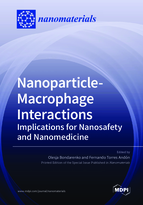Nanoparticle-Macrophage Interactions: Implications for Nanosafety and Nanomedicine
A special issue of Nanomaterials (ISSN 2079-4991). This special issue belongs to the section "Biology and Medicines".
Deadline for manuscript submissions: closed (20 June 2021) | Viewed by 31697
Special Issue Editors
2. University of Helsinki, HiLIFE unit Helsinki, Finland
Interests: nanoparticles; antibacterial nanoparticles; nanotoxicology; cell-nanoparticle interactions; nanoparticle-mediated drug delivery
2. IRCCS Istituto Clinico Humanitas, Via A. Manzoni 56, 20089 Rozzano, Milan, Italy
Interests: nanoparticles; macrophages; monocytes; innate immune system; immunotoxicity; cell death; surface functionalization; immunotherapy; macrophage-nanoparticle interaction
Special Issue Information
Dear colleagues,
Nanoparticles (NPs) offer unique physicochemical properties useful for biomedical applications, e.g., as antibacterials, vaccine adjuvants, and bioimaging and/or antitumoral agents. Medical use of NPs commonly implies their injection into the bloodstream, but other routes have been explored, such as the subcutaneous, oral, intranasal, inhalation or transdermal administration. Once in the body, NPs are inevitably recognized by the immune system. Macrophages are a major class of phagocytic innate immune cells, specializing in the neutralization and/or uptake of foreign material (including NPs) and consequent mounting of an immunological response. The mechanisms implicated in the uptake of NPs by macrophages determine the lifetime of NPs in relevant biological fluids or tissues, which has consequences for their nanosafety and biomedical applications. Various safe-by-design strategies, such as pegylation and other surface functionalizations of NPs, have been implemented to manipulate the recognition of NPs by monocytes/macrophages and, thus, their immunotoxicological properties. Of note, NPs have been also designed on purpose to target macrophages with the aim to trigger or to inhibit immune responses, for example, killing or reprogramming the tumor associated macrophages.
The aim of the current Special Issue is to cover recent advancements in our understanding of NP-macrophage interactions using in vitro, in vivo, and in silico approaches, novel strategies to control the toxicological and immunological profile of NPs, and innovative ways to modulate the delivery of NPs towards macrophages for safety and medical purposes.
Dr. Olesja Bondarenko
Dr. Fernando Torres Andón
Guest Editors
Manuscript Submission Information
Manuscripts should be submitted online at www.mdpi.com by registering and logging in to this website. Once you are registered, click here to go to the submission form. Manuscripts can be submitted until the deadline. All submissions that pass pre-check are peer-reviewed. Accepted papers will be published continuously in the journal (as soon as accepted) and will be listed together on the special issue website. Research articles, review articles as well as short communications are invited. For planned papers, a title and short abstract (about 100 words) can be sent to the Editorial Office for announcement on this website.
Submitted manuscripts should not have been published previously, nor be under consideration for publication elsewhere (except conference proceedings papers). All manuscripts are thoroughly refereed through a single-blind peer-review process. A guide for authors and other relevant information for submission of manuscripts is available on the Instructions for Authors page. Nanomaterials is an international peer-reviewed open access semimonthly journal published by MDPI.
Please visit the Instructions for Authors page before submitting a manuscript. The Article Processing Charge (APC) for publication in this open access journal is 2900 CHF (Swiss Francs). Submitted papers should be well formatted and use good English. Authors may use MDPI's English editing service prior to publication or during author revisions.
Keywords
- nanomaterials
- macrophages
- immunotoxicity
- cytotoxicity
- surface functionalization
- macrophage–nanoparticle interaction








